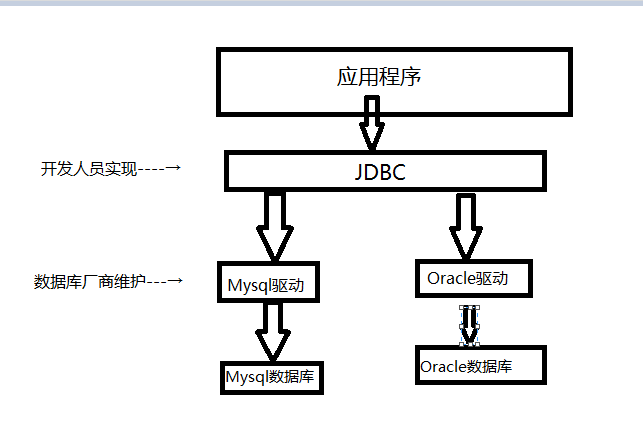标签:stat ams 参数 rom mit 初始 aaa init 用户名
JDBC:(JavaDatabase Connectivity:java数据库连接):什么是JDBC?
SUN公司为了简化开发人员(对数据库统一)的操作,提供了一个java操作数据库的规范,这就是JDBC。
或者说,JDBC是一款实现不同数据语言驱动的接口。
JDBC的操作步骤:
SQL语句对象--→4. 执行SQL语句--→5. 处理查询结果集(如果SQL语句不是select语句,那不需要这一步)--→6. 释放资源package JDBC;
import java.sql.*;
import java.util.ResourceBundle;
public class jdbcUse {
public static void main(String[] args) {
//1. 使用资源绑定器绑定属性配置文件(配置文件包括注册,登录)
ResourceBundle jdbc = ResourceBundle.getBundle("JDBCbd");
String Driver = jdbc.getString("Driver");
String url = jdbc.getString("url");
String user = jdbc.getString("user");
String password = jdbc.getString("password");
//2. 定义连接对象初始值为null
Connection connection = null;
//3. 定义操作数据库语言对象初始值为null
Statement statement = null;
try {
//4. 利用配置文件数据进行--注册,登录
Class.forName(Driver);
connection = DriverManager.
getConnection(url,user,password);
//5. 获取数据库操作对象
statement = connection.createStatement();
//6. 执行SQL语句
String sql = "insert into dept(deptno,dname,loc) values(40,‘SMITHS‘,‘KEORA‘)";
int i = statement.executeUpdate(sql);
System.out.println(i == 1 ? "true" : "false");
//6.5 获取查询结果集
// 7. 释放资源
} catch (Exception e) {
e.printStackTrace();
} finally {
if (statement != null) {
try {
statement.close();
} catch (SQLException e) {
e.printStackTrace();
}
}
if (connection != null) {
try {
connection.close();
} catch (SQLException e) {
e.printStackTrace();
}
}
}
}
}
JDBC功能实现用户的模拟登录案例;package Case;
import java.sql.*;
import java.util.*;
//总结:老师在课上讲的步骤要清楚,编程思维:我理解的是,遇到编程方面问题,第一时间会想到相对固定的解决方案,即;泛型的使用,hashmap的使用,添加变量的使用等等。
//唯手熟尔,多转换思维把,加油练!
public class aaa {
public static void main(String[] args) {
//要干嘛? 模拟使用数据库中数据进行登录操作;
//登录需要什么? 账号密码呀!
//用什么存储账号密码最方便? HashMap呀
//HashMap怎么用? 明天学
//操作步骤
//1. 获取一个存放账号密码的HashMao
Map<String, String> userLoginInfo = initUI();
//2. 判断这个存储账号密码的HashMap是否正确
boolean loginSuccess = login(userLoginInfo);
//3. 正确返回什么,错误返回什么
System.out.println(loginSuccess ? "登录成功" : "登录失败");
}
/**
* 验证用户名和密码
* @return boolean
* @params userLoginInfo
*/
private static boolean login(Map<String, String> uIL) {
boolean loginSuccess = false;
Connection connection = null;
Statement statement = null;
ResultSet resultSet = null;
ResourceBundle bundle = ResourceBundle.getBundle("case_userLogin");
String getName = uIL.get("userName");
String getPwd = uIL.get("password");
String driver = bundle.getString("Driver");
String url = bundle.getString("url");
String user = bundle.getString("user");
String password = bundle.getString("password");
try {
Class.forName(driver);
connection = DriverManager.getConnection(url, user, password);
statement = connection.createStatement();
String sql = "select * from t_user where loginName = ‘"+ getName+"‘ and loginPwd = ‘"+getPwd+"‘";
resultSet = statement.executeQuery(sql);
//resultSet.next()可以判断是否有数据
if (resultSet.next()) loginSuccess = true;
} catch (Exception e) {
e.printStackTrace();
} finally {
if (resultSet != null)
try {
resultSet.close();
} catch (Exception e) {
e.printStackTrace();
}
if (statement != null)
try {
statement.close();
} catch (Exception e) {
e.printStackTrace();
}
if (connection != null)
try {
connection.close();
} catch (Exception e) {
e.printStackTrace();
}
}
return loginSuccess;
}
/**
* 初始化用户界面
*
* @return 返回用户用户名和密码信息
* @params 没有参数
*/
private static Map<String, String> initUI() {
Scanner s = new Scanner(System.in);
System.out.println("用户名:");
String userName = s.nextLine();//一次读一行;
System.out.println("密码:");
String password = s.nextLine();
Map<String, String> userloginInfo = new HashMap<>();
userloginInfo.put("userName", userName);
userloginInfo.put("password", password);
return userloginInfo;
}
}
JDBC:(JavaDatabase Connectivity:java数据库连接):
标签:stat ams 参数 rom mit 初始 aaa init 用户名
原文地址:https://www.cnblogs.com/denghao7/p/14860216.html